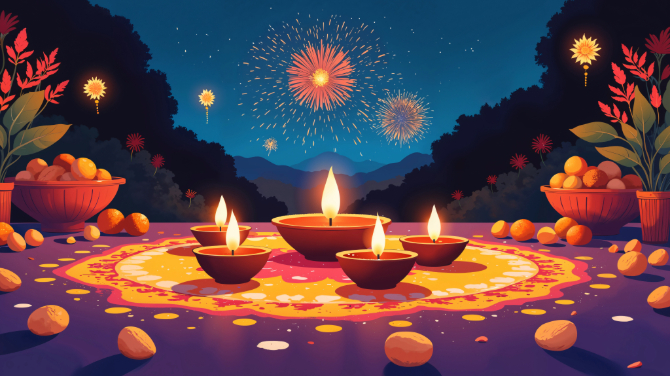
Recognized as one of the most cherished and spiritually rich celebrations, this vibrant occasion brings families and communities together in joy and reflection. Amid glowing lamps, traditional sweets, and heartfelt rituals, Diwali, the Festival of Lights, carries a deeper purpose that extends beyond festivities. Each of its five days, from Dhanteras to Bhai Dooj, represents a unique spiritual milestone rooted in mythology, inner transformation, and the timeless journey from darkness to light.
Day 1: Dhanteras – Honoring Health, Wealth, and Divine Protection
Dhanteras marks the start of Diwali and sets a reverent tone for wealth and health. This day honors Lord Dhanvantari, the divine physician and an incarnation of Lord Vishnu, who emerged from the cosmic ocean during the Samudra Manthan while holding a pot of Amrit (nectar of immortality).
Many people buy gold, silver, or utensils on this day, but the real essence is about inviting positive energy, abundance, and well-being into our lives. It serves as a reminder to nurture both material prosperity and our physical and spiritual health.
Lighting a lamp on Dhanteras represents dispelling ignorance and illness. On a soul level, it’s a day to cleanse our hearts, set intentions, and prepare to receive the divine energies of the coming days.
Day 2: Naraka Chaturdashi (Choti Diwali) – Victory Against Inner Darkness
Often called Choti Diwali, this day honors Lord Krishna’s victory over the demon Narakasura, who had imprisoned many women. After his defeat, the imprisoned souls were freed, which symbolizes the release of suppressed energies and liberation from bondage.
Spiritually, Naraka Chaturdashi is about overcoming our inner demons—anger, jealousy, greed, and ego. It reminds us that the true battle is within, and only through divine strength, self-awareness, and humility can we find inner peace.
Many do an Abhyanga Snan (ritual oil bath) before sunrise as a sign of purification. Lighting diyas in the evening is not just for beauty but serves as a sacred act to invite divine light into our lives, helping us burn away emotional and mental negativity.
Day 3: Lakshmi Puja (Main Diwali Day) – Welcoming the Goddess of Light and Fortune
The heart of Diwali is Lakshmi Puja, the third and most celebrated day. People decorate their homes with rangoli, lamps, flowers, and sacred symbols of prosperity, such as lotus flowers and footprints of Goddess Lakshmi.
Beyond the rituals and offerings, this day calls us to welcome not just wealth into our homes but also abundance in our hearts and minds. Goddess Lakshmi, who is the partner of Lord Vishnu, signifies not only material riches but also reflects purity, generosity, and spiritual wealth.
Cleanliness, devotion, and gratitude are vital for attracting her blessings. Many stay up late, lighting lamps and candles to guide the Goddess into their homes. On a deeper level, it’s a night for kindling the light of devotion and clarity within, dismissing ignorance, and embracing divine wisdom.
This day is also the new moon night (Amavasya)—a time deemed spiritually strong for introspection and setting new intentions. Even in the darkness of the moonless sky, we remember that divine light shines brightest in our darkest moments.
Day 4: Govardhan Puja – Surrender and Faith in Divine Shelter
The day following Diwali is referred to as Govardhan Puja or Annakut, predominantly celebrated in the northern regions of India. It marks the occasion when Lord Krishna lifted the Govardhan Hill on his little finger to protect the villagers of Vrindavan from the wrath of Indra, the rain god.
Spiritually, this day teaches complete surrender to the divine, trusting that the universe will protect and provide when we let go of fear and ego. It also celebrates nature’s abundance and shows gratitude to Mother Earth, represented by the Govardhan Hill.
Devotees create substantial food offerings (Annakut) as an expression of love and gratitude. This day is not just about rituals but about remembering that faith, devotion, and humility can shelter us from life’s storms.
Day 5: Bhai Dooj – Celebrating the Sacred Bond of Souls
The fifth and final day of Diwali is Bhai Dooj (or Bhau Beej), a celebration of the sacred bond between brothers and sisters. Spiritually, it reminds us that our relationships are more than social ties; they are soul connections that transcend lifetimes.
According to the legend, on this day, Yamraj, the deity of death, came to see his sister Yamuna. She welcomed him with love, tilak, and sweets, and in return, he blessed her with protection. This day signifies love, blessings, and protection among siblings.
Bhai Dooj encourages us to honor and value the divine within each other, offering prayers not just for our loved ones but for all beings. It reinforces that love, respect, and unity are the cornerstones of a spiritually fulfilling life.
A Festival of the Soul
Diwali is more than a festival; it’s a sacred journey from darkness to light, ignorance to wisdom, fear to faith. Each of the five days offers a chance to reflect, reconnect with our higher selves, and align with universal energies.
- Dhanteras reminds us to value health and divine wealth.
- Choti Diwali urges us to confront and defeat our inner demons.
- Lakshmi Puja marks the beginning of an influx of spiritual and material abundance.
- Govardhan Puja emphasizes the value of surrender and the divine’s protective embrace.
- Bhai Dooj celebrates soul bonds and mutual blessings.
As we light diyas and decorate our living spaces, let us also enrich our hearts with love, compassion, and wisdom. May Diwali be more than just a festival; let it be a transformation. A time to reset not only our homes but also our hearts.







